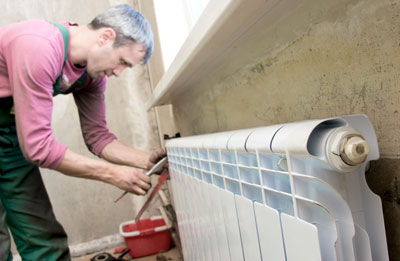
IN THIS ISSUE:
Grantee Spotlight: Albuquerque’s Bridge Boulevard Redevelopment Plan
Mixed-Use, Mixed-Income Development near Rail Transit in Reading, Massachusetts
ARRA-Funded Energy-Efficiency Program Seeds Private-Sector Financing
Earn-A-Bike Aims to Get the University of Louisville Cycling
ARRA-Funded Energy-Efficiency Program Seeds Private-Sector Financing

With initial financing from the American Recovery and Reinvestment Act of 2009, the CHF Residential Energy Retrofit Program provides loans to low- and moderate-income householders for comprehensive energy-efficiency improvements. Image courtesy of Shcherbakov Ilya.The American Recovery and Reinvestment Act of 2009 (ARRA) provided billions of dollars in financing to homeowners, businesses, and local governments to invest in energy-efficiency and renewable-energy technology through the Department of Energy’s State Energy Program. The influx of available capital into the residential energy-efficiency market was intended to remove the barriers to efficiency upgrades, including the upfront costs of retrofitting a home. The intent was also to foster long-term growth in energy-efficiency and renewable-energy technology through a scaled response supported by the private sector.
With most ARRA funds for energy-efficiency improvements expended, private financing and a trained workforce are fueling greater market penetration and providing promising signs for the future of the industry. Leaders from the California Rural Home Mortgage Finance Authority Homebuyers Fund (CHF) recently announced the continuation of the CHF Residential Energy Retrofit Program (formerly known as the Moderate Income Sustainable Technology Program) through a unique partnership that engages private investment, an investor-owned utility, and the public sector. Originally funded with $29 million in ARRA funds administered through the California Energy Commission in 2010, the latest version of the program is made possible through $20 million in loans from Sacramento-based Five Star Bank.
Picking Up Where a Successful Program Left Off
The extension of the CHF program builds on the success of its ARRA-funded predecessor and represents an important step toward creating a scalable program model. Designed to provide zero-percent and low-interest (3%, fixed-rate, 15-year term) loans and small grants to low- and moderate-income homeowners (those earning between 60% and 160% of the area median income), the original program allowed approximately 1,050 homeowners to upgrade their homes. The efficiency measures yielded an average energy savings of 34 percent and helped preserve and create 329 jobs in rural California. The typical home underwent $24,000 in improvements. These “deep retrofits” — which often include new HVAC equipment and upgrades to the building envelope and ductwork — aim to supplant the incremental approach many homeowners adopt with a comprehensive energy-efficiency strategy that recognizes a building and its various components as a single system.
When all the program resources had been allocated, nearly 100 applicants were on a waiting list for retrofits. In response to this demand and to support the larger goal of increased market presence, the program’s sponsors (CHF and the California Energy Commission) sought a sustainable flow of capital for energy-efficiency improvements. This financing came from a unique partnership between Five Star Bank and one of the state’s investor-owned utilities, Pacific Gas and Electric Company (PG&E). Five Star has initially committed to provide $20 million in loans at 6.5-percent interest (fixed rate, 15-year term), and PG&E will establish a loan loss reserve to keep interest rates attractive for consumers and insure Five Star against loan defaults. According to Carolyn Holmes, marketing director for CHF, the loan product will generate a competitive investment return for the bank while providing homeowners with terms that allow energy savings to help offset the cost of the loan.
Because the initial ARRA investment provided training for contractors as a workforce development strategy, contractors are responsible for most marketing, outreach, and business development. This has minimized CHF’s administrative fees for the program. “Our goal is to get out of the way and to have contractors responsible [for building a pipeline of projects]. This is reflected in how the program was originally designed, and the involvement of a private lender [is an important step in that direction],” notes Holmes. A contractor’s responsibility also includes ensuring that homeowners maximize additional rebates and incentives available for energy-efficiency improvements through Energy Upgrade California.
Five Star’s involvement in the program also means that financing will be made available to homeowners regardless of income. However, because PG&E is supporting the program through its public benefits charge, only PG&E customers currently qualify for the program. According to Holmes, CHF is working with other investor-owned utilities in the state to expand the program’s reach beyond PG&E customers.
